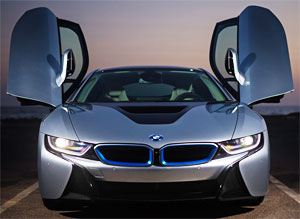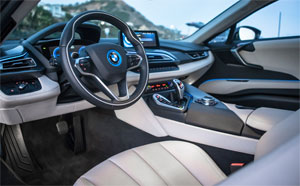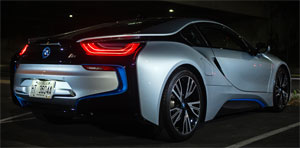2015 BMW i8
In the more than three decades that MotorWeek has been on the air we’ve seen electric cars grow from homemade curiosities, to mass production icons. But, the public appetite for pure EVs remains stymied over range and cost. Both problems that plug-in hybrids are better able to solve. Still, most PHEVs haven’t been very exciting to drive. But what about this plug-in…the BMW i8… This futuristic concept car brought to life certainly looks exciting. So let’s see if it drives that way.
Looking like it just drove off the set of Buck Rogers in the 25th Century, comes BMW’s first take on an integrated plug-in hybrid, the 2015 BMW i8. It looks like nothing you’ve seen, yet somehow appears exactly what you’d expect an advanced hybrid from BMW to look like.
Like everything else you see, the hybrid hardware is BMW’s own design and has both front and rear axle power sources that work both separate and together.
 Driving the rear wheels is a 1.5-liter turbo-I3. Yes folks, it has come to that, a 3-cylinder engine in a supercar. And, yes again, it’s the same engine used in the new MINI Cooper. Placed forward, with power for the front wheels is a more expected 96-kW electric motor that draws from a water-cooled 5.0-kWh lithium-ion battery pack lying low in the chassis.
Driving the rear wheels is a 1.5-liter turbo-I3. Yes folks, it has come to that, a 3-cylinder engine in a supercar. And, yes again, it’s the same engine used in the new MINI Cooper. Placed forward, with power for the front wheels is a more expected 96-kW electric motor that draws from a water-cooled 5.0-kWh lithium-ion battery pack lying low in the chassis.
Working in harmony, they produce 357-horsepower and 420 lb-ft. of torque. And much like a traditional hybrid, a high-voltage starter/generator attached to the gas engine does double duty by feeding power back into the batteries. BMW claims that when in Sport mode, every mile you drive adds one mile of EV-range. Talk about having your fun and economizing it too.
The battery can also be charged on 110 or 220-volt circuits.
While the power distribution is constantly shuffled between the axles, you can plan on strictly EV operation only if you take it easy on the throttle at speeds up to 75 miles-per-hour. Step into it and you’ll hear the internal combustion party start behind you.
You can also manually engage EV-mode. The government rates the range at 15-miles. But much like the Chevrolet Volt, you’ve got about a 300 mile range on just gas after that.
Amazingly, BMW was able to keep the i8 iLooking remarkably like the original concept car, even retaining the scissor-wing doors and Carbon Fiber Reinforced Plastic passenger cell. With that and extensive use of other lightweight materials like magnesium and aluminum, the i8 weighs in at 3,285 lbs.
Because of those doors, getting in and out can be a bit of a challenge, like many supercars; and yet another reminder that this car is much cooler than we are.
 Once in, some found the seats very comfy, others not so much. But all agree the seating position is very low. Shorter drivers could not see over the nose which made tight maneuvers scary.
Once in, some found the seats very comfy, others not so much. But all agree the seating position is very low. Shorter drivers could not see over the nose which made tight maneuvers scary.
Navigation and most expected high-tech comfort and safety amenities are standard, and we applaud the use of familiar controls right off the BMW parts shelf. And that even includes the iDrive central controller. Also on the console are a simple electronic shifter, Driving Experience Control, and eDrive switch.
Looking cool is one thing, but driving down the road the i8 is very cool as well. There’s plenty of engine noise electronically pumped into the cabin and it certainly doesn’t sound like a 3-cylinder. Engage Sport Mode and you’ll get a whole new level of responsiveness, both from the throttle and throughout the chassis.
Transitions between gas and electric drive are fairly smooth, though there are times when getting real aggressive on the throttle results in the car taking a second to process where to send the power. But other than that, it’s a mostly seamless affair. Brakes are very touchy in the usual electric-drive manner.
As for acceleration, with launch control engaged, we hit 60 in 4.4-seconds. There’s instant torque off the line and shifts from the 6-speed automatic transmission came in a hurry. Those shifts are very firm and quick, and had us thanking BMW for not succumbing to a CVT as we worked our way to the end of the ¼-mile in 12.9-seconds at a thrilling 110 miles-per-hour.
 The suspension is also a mix of something old and something new. The design is double-wishbone front and 5-link rear, but dynamic damping control and electric power steering are standard. Combined, they keep the i8 flatter than Kansas through the corners.
The suspension is also a mix of something old and something new. The design is double-wishbone front and 5-link rear, but dynamic damping control and electric power steering are standard. Combined, they keep the i8 flatter than Kansas through the corners.
Combined Government Fuel Economy Ratings are 28 MPG for gas-only driving; that’s about 20% lower than the Volt, with 76 MPGe for i8 gas-electric operation. We drive mostly in Sport mode and recorded 33.5. Our Euro-spec model prevented proper plug-in charging so we think owners will likely double our test figures.
We’ve certainly entered a new era of supercars. Lightweight, small-engine, electric-assist wonders that aim for high fuel economy just as much low 0-60 and lap times. And while the i8 is far from being the ultimate straight-line performer, its $135,700 price tag is only a fraction of the price of most other high performance plug-ins.
So after driving BMW’s view of the future, we can absolutely say that the 2015 i8 will forever change the way you think about plug-in hybrids. And with cars like this, it’s clear that gasoline, electric, and high performance, can smoothly live together as one.
Specifications
- Engine: 1.5-liter turbo-I3
- Horsepower: 357
- Torque: 420 lb-ft.
- 0-60 mph: 4.4 seconds
- 1/4 mile: 12.9 seconds @ 110 mph
2025 Volkswagen ID. Buzz
Volkswagen Brings Beetlemania Level Of Excitement To Minivan Segment
The duty of upholding Volkswagen’s heritage has most recently been delegated to small legacy car names like Golf and Jetta. But hold on! A much larger, totally modern take on VW’s classic microbus has just buzzed over the horizon— the all-electric ID. Buzz. It’s been at the top of our minds since we first saw the concept back in 2017. Well, it’s finally here, so let’s get our groove into drive!
This 2025 Volkswagen ID. Buzz has indeed created the most buzz around Volkswagen since the Beetle’s return to the U.S. in the late 1990s. We couldn’t drive it anywhere without drawing a crowd. No wonder, just about everyone has a VW Microbus story to tell, and seeing this reimagined version rolling down the street brings back all those memories.
VW really pulled it off as far as we’re concerned, as it looks great without appearing over the top. All the cues are here: Big VW logo front and center, lots of greenhouse including A-pillar windows and mini sliders for the second-row passengers, D-pillar air vents, and two-tone wheels. And while its appearance may be pure retro, its drivetrain is far from it, as the ID. Buzz is all-electric, and unlike the new Beetle, the Buzz does retain the original Microbus’ rear-drive architecture.
Powering those rear wheels is a 210-kW motor drawing juice from a 91-kWh battery for a range of 234 miles; 200-kW max charging will get you to 80% in about 26 minutes. Buyers can add another small 80-kW motor up front for 4motion all-wheel-drive and an increase of total output from 282 to 335 horsepower with a combined 512 lb-ft of torque. It uses the same battery, but range estimates drop just slightly to 231 miles. But while those numbers are modest, we also found them to be quite conservative, as we observed as many as 287 miles available in our all-wheel-drive tester’s gauge display and were on pace for 273 miles in our driving loop.
One throwback theme that may be a turnoff to some is that it’s quite a step up into the Buzz’s front seats, but there’s certainly a commanding view of the road once you climb in. Second row seating can be either a three-place bench or a pair of captain’s chairs, so there’s generous room for seven or six passengers. The captain’s chairs in our Pro S Plus offer good support and very easy access to the third row.
Lots of flexibility too with the option to simply fold the seats or remove them altogether.
With the sliding side doors and a wide opening rear hatch, there’s plenty of access for loading big sport utility amounts of cargo. Lots of flexibility too with the option to simply fold the seats or remove them altogether, and the ability to create a full-length flat floor with a rear cargo shelf that covers some handy removable storage bins. There’s 18.6 cubic-feet of space behind the third row, 75.5 behind the second, and a max of 145.5. That’s more than a Chevrolet Tahoe. For smaller items, there are lots of cubbies throughout the cabin, along with a standard Buzz Box that can be moved to multiple locations.
With a design that prioritizes retro form and modern function over aero efficiency, the 4motion equipped ID. Buzz earns a Fair efficiency rating, using 42-kWh of electricity per 100 miles, and we weren’t sure what to expect at our Mason Dixon test track.
What we found was great torque off the line and drama free launches to 60 in just 5.3 seconds. It was very stable at speed and power delivery stayed steady most of the way down the track until we reached about 90 mph, when it began to taper off just before we finished the quarter-mile in 14.0 seconds flat at 97 mph.
With 1,200-lbs. of battery weight nestled in its 127.5-inch wheelbase, the Buzz felt planted to the pavement through our handling course. There was quite a bit of body roll to deal with, but surprisingly little understeer. In panic braking runs, pedal response was inconsistent, feeling soft at times, pushing back hard at others; but through it all, results were quite good, stopping from 60 in an average of just 108 feet.
Three interior themes are available, this Dune is the brightest, featuring coastal inspired wood optic dash décor, “gray and clay” leatherette surfaces, and a high-mounted central 12.9-inch touchscreen. Pricing starts with a rear-wheel-drive Pro S at $61,545; this Pro S Plus begins at $65,045, add another $4,500 for 4motion, which brings a few extra features along with all-wheel drive.
Retro design with old-school VW charm, modern EV drivetrain, big SUV capacity merged with minivan flexibility; it all comes together in this 2025 Volkswagen ID. Buzz. It’s easily one of the coolest rides of the year and one that will likely keep Volkswagen dealers buzzing for years to come, and that’s something no other people and things mover can say.
Specifications
As Tested
- Motor Setup: Dual-Motor AWD
- Battery Size: 91-kWh
- Horsepower: 335
- Torque: 512 lb-ft
- EPA Range: 231 miles
- 0-60 mph: 5.3 seconds
- 1/4 Mile: 14.0 seconds at 97 mph
- Braking, 60-0: 108 feet
- MW Test Loop: ~ 273 miles













































